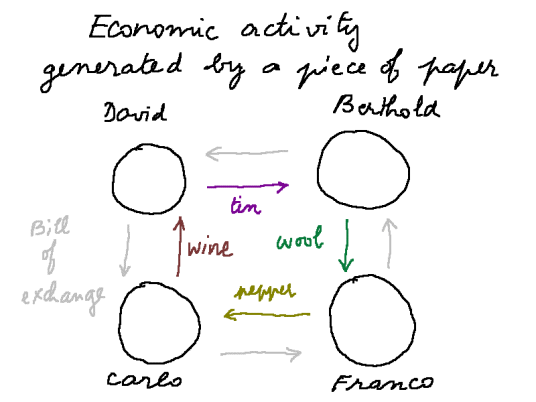
A swindler buys a statue from an antique dealer, and writes a cheque of $100 000 to pay for it. The antique dealer makes a $25 000 profit from the sale. Then the antique dealer goes to a car dealer and buys a sports car for $100 000, which he pays by endorsing the previous cheque and giving it to the car dealer. The latter makes a $25 000 profit in the sale. Then the car dealer goes and buys something costing $100 000 from a third shop, which again makes a $25 000 profit. The car dealer pays with the same cheque endorsed once more. And so on until we reach a tenth shop manager, which makes a sale of $100 000 to the ninth, and makes a profit of $25 000. But this tenth shop manager takes the cheque to its bank. The bank tells him that it is a "rubber cheque", that is, it is not covered by a balance in credit in the swindler's account. So the last shop manager suggests to the other nine managers that they all pay $10 000 in order to cover the cheque. They accept to do so.
When we step back and study what happened, we see that the circulation of a fake cheque was able to trigger $1 000 000 of real business and $250 000 of real profits, of which we should only subtract $100 000 of losses to cover the bad cheque.
Conclusion: money is just signs which can create real wealth.
Post-scriptum 1: the swindler running away with some asset is not fundamental to the example. He could be caught by the police, and hand back the statue, or even confess that he is actually a finance teacher who was trying to make a point. Then the society, on top of the $150 000 of net profit, made a public purchase of a statue that now adorns the central square of the town where the story took place.
Post-scriptum 2: this example is not different from the economic activity generated by David's bill of exchange. There is no need for gold (which in fact is just signs too). Here is four exchanges and therefore economic wealth generated by a simple bill of exchange. (It is assumed, to make the example simple, that the four goods exchanged have the same selling price.)

This four-fold exchange does create economic wealth, exactly like when a shop sells for 100 some goods recorded at 70 in its inventory. The value added by the shop is the selection, inventory maintenance, display, counselling of clients, etc.